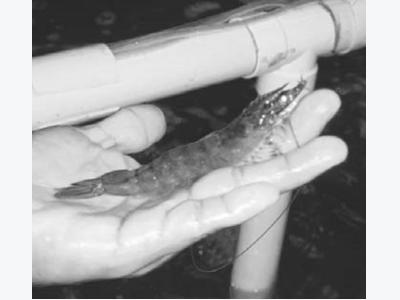Four-Phase, Biosecure System Produces Shrimp Broodstock in Ecuador

One of the main concerns in dealing with White Spot Syndrome Virus (WSSV) in Ecuador has been the implementation of new management strategies in broodstock growout practices. One approach is to import Litopenaeus vannamei nauplii, which are believed to perform better than traditional broodstock lines selected from surviving shrimp in growout farms.
At LARFICO, broodstock like this 20-g animal are raised in raceways.
At LARFICO, a hatchery and maturation facility in Punta Barandua, Ecuador, pond animals are typically infected with WSSV, Infectious Hypodermal and Hematopoietic Necrosis Virus, Taura Syndrome Virus, and other pathogens. Therefore, a recirculation system for broodstock production was designed and built to promote biosecurity and manage the growout of broodstock in raceways in a controlled environment.
Nauplii are imported from a biosecure hatchery in Panama, which is an effective alternative to the traditional method of raising broodstock from local farms. Broodstock are grown through a four-phase, biosecure system and a rigorous selection procedure.

Recirculating, indoor growout raceways incorporate biofilters and skimmers.
Broodstock Production
During the first run of the system – the results of which are reported here – both raceways and circular tanks were used, in case of unexpected problems.In subsequent runs, animals were stocked in raceways during phase 3, as designed
All water used in the broodstock production system is chlorinated and then filtered through 5- and 1-μfilters. Water for outdoor raceways is also treated with ozone
Efficient water circulation to the tanks is provided by a 1-hp pump. Water goes through a series of pipe airlifts with 75-mm diameter, a sand filter, a venturi-injected protein skimmer, and a trickle biofilter
The biofilter is made of PVC crates arranged in five layers. The first layer has carbon and 25-mm-thick filter material. The other four layers have the same filter material on the bottom, but are filled with virgin PVC scrap material as a media for the colonization of nitrifying bacteria
This relatively simple trickle filter provides both sufficient nitrification and degasification to maintain up to 1.2 kg/m3. A5% water exchange is the minimum necessary for replacing water lost during routine siphoning of detritus from tank bottoms and back washes to clean the sand filter.
Four Phases
This system has four phases. The first two take place in a semiopen system, using 6-ton circular tanks of 3 m diameter. The other two take place in a closed, recirculating system using 40-ton oval raceways (14 x 4 m). Shrimp are selected based on 17 criteria as they go from phase to phase.
Phase 1
This initial phase lasts three weeks. About 200,000 postlarvae are stocked in six 10-m2 tanks. Tank water (34 ppt, 30° C) is moved using four sets of airlifts, with about 30% exchange daily. Animals are fed Chaetoceros gracilis (at a density of 200,000 cells/ml) and a commercial nursery diet. Shrimp are harvested in this phase at an average weight of 0.25 g.
Phase 2
In phase 2, 10,000, 0.25-g shrimp are stocked in 48-m2 raceways and grown for six weeks. Water is moved through eight sets of airlifts, and pumped through the sand filter, protein skimmer, and trickle biofilter, with 5-10% daily exchange. Animals are fed a commercial diet and and harvested at an average weight of 5 g.
Phase 3
Phase 3 lasts eight weeks. Six thousand 5-g juveniles are stocked in each raceway. They are fed a commercial broodstock diet at 6% of biomass. Shrimp are harvested at an average weight of 15 g.

Figure 1. Growth of selected broodstock from LARFICO and nonselected broodstock.
Phase 4
In the last phase, 1,000, 15-g shrimp are stocked in each raceway for 16 weeks. During this phase, males and females are separated. Animals are fed a commercial broodstock diet at 3% of biomass and squid at 6-12% of biomass daily. Shrimp are harvested at a maximum weight of about 30 g.
Survival and Growth Rate
In early January 2002, LARFICO finished the first cycle and harvested shrimp with an average size of 29.8 g from six female raceways. Shrimp harvested from four male raceways averaged 25.4 g. Overall survival was 77.8%, and growth rate averaged 1.3 g/week from phase 3 on.
Conclusion
The LARFICO system is very effective at producing biosecure shrimp broodstock. It is relatively simple to build and operate, cost-effective, and flexible due to its modular design. The system can achieve:
- Better growth and survival of selected broodstock (Figure 1).
- Breeder production from a small number of postlarvae (100,000
- Significant biosecurity.
- Constant monitoring and ease of handling of broodstock.
- Phenotypic selection and coding of shrimp in each phase of the system.
- High growth performance selection at very intensive stocking densities.
Author:
Christian Graf - Maturation Consultant Broodstock and Maturation Program LARFICO Punta Barandua, Ecuador barandualab@yahoo.com
Related news
 Feed management improves profits in intensive white shrimp farming
Feed management improves profits in intensive white shrimp farming To ensure optimal water quality and clean pond bottoms at shrimp farms, choosing consistently goodquality feed and close monitoring of feed trays supported
 Two-Stage Selection Key For Fast Shrimp Growth In Mexico
Two-Stage Selection Key For Fast Shrimp Growth In Mexico The largest shrimp hatchery in Mexico has implemented a two-stage selection program based on body weight at 28 days of age and and body weight at 130 days
 Effective Management Of WSSV In Shrimp - A Seven-Step Program
Effective Management Of WSSV In Shrimp - A Seven-Step Program As research on WSSV continues, common-sense steps can lessen the potential impacts of white spot syndrome virus on shrimpfarming operations